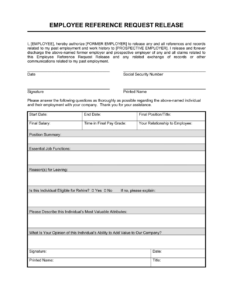This article will delve deeper into the core components of these valuable documents, exploring best practices for creation and usage, and addressing legal considerations to ensure a compliant and effective recruitment process.
Key Components of an Employment Reference Request
Effective reference requests contain essential elements that facilitate a comprehensive understanding of a candidate’s suitability for a position. These components ensure consistent data collection and promote efficient communication between employers and referees.
1. Candidate Information: This section identifies the individual about whom the reference is being requested, including their full name and the position they have applied for. Clear identification ensures the referee can accurately connect the request to the correct individual.
2. Requestor Information: Details of the organization requesting the reference are crucial. This typically includes the company name, contact person, their title, phone number, and email address. Providing complete contact information allows for easy follow-up and clarification if needed.
3. Relationship Verification: Confirmation of the referee’s relationship to the candidate, including the dates of their professional association, and the capacity in which they interacted (e.g., supervisor, colleague) provides context for the subsequent evaluation.
4. Employment Dates: Specific dates of the candidate’s employment are crucial for verifying the accuracy of the information provided and understanding the duration of their experience.
5. Job Title and Responsibilities: A clear description of the candidate’s previous role and responsibilities helps the referee focus their feedback and provides relevant context for evaluating their skills and performance.
6. Performance Evaluation: This section often includes questions about the candidate’s skills, strengths, weaknesses, and overall performance. Open-ended questions can encourage more detailed and insightful responses.
7. Eligibility for Rehire: This straightforward question allows organizations to understand whether the candidate would be considered for re-employment by their previous employer, providing valuable insight into their overall work ethic and suitability.
8. Authorization and Consent: A statement indicating that the candidate has authorized the reference check is essential for legal compliance and ethical practices.
By incorporating these elements, reference requests provide a structured and efficient means of gathering valuable insights into a candidate’s background and suitability for a role. This systematic approach ensures a fair and informed hiring process.
How to Create an Employment Reference Request Template
Creating a standardized template streamlines the reference-checking process, ensuring consistency and efficiency. A well-designed template gathers essential information while respecting the time of both the referee and the hiring organization.
1: Define the Purpose: Clarify the specific information required from referees. Focusing on job-relevant skills and experience helps ensure responses align with the position’s requirements.
2: Gather Essential Information Fields: Include sections for candidate information, requestor details, employment dates, job title and responsibilities, and performance evaluation questions. Consider adding a section on eligibility for rehire.
3: Craft Clear and Concise Questions: Use open-ended questions to encourage detailed responses, but avoid ambiguity. Specific, targeted questions yield more valuable insights.
4: Incorporate Authorization and Consent: Include a statement for candidates to authorize the release of information, ensuring legal compliance and ethical practices.
5: Choose a Professional Format: Opt for a clean and easy-to-read layout. A professional design reflects positively on the organization.
6: Test and Refine: Pilot the template with a small group to identify areas for improvement. Feedback can enhance clarity and effectiveness.
7: Ensure Accessibility: Consider providing the template in multiple formats (e.g., Word document, PDF) to accommodate various accessibility needs.
A thoughtfully designed template improves the reference-checking process, enabling informed hiring decisions. Regular review and updates maintain relevance and ensure the template remains a valuable tool.
In conclusion, a standardized approach to requesting employment references provides a crucial framework for gathering consistent and pertinent information. Utilizing a well-designed template streamlines the process, ensuring efficiency and facilitating informed hiring decisions. Key components, such as candidate and requestor information, clear questions regarding past performance and rehire eligibility, and authorization for release of information, contribute to a thorough and legally compliant process. Careful consideration of these elements, combined with regular review and refinement, maximizes the effectiveness of this valuable tool.
Organizations committed to effective recruitment practices recognize the importance of structured reference checks. By embracing a systematic approach, organizations can gain valuable insights into prospective employees, mitigate potential risks, and ultimately cultivate a thriving workforce. This dedication to due diligence fosters a more robust and successful hiring process, contributing to long-term organizational growth and stability.

